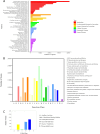Rosuvastatin ameliorates obesity-associated insulin resistance in high-fat diet-fed mice by modulating the gut microbiota and gut metabolites
- PMID: 40661966
- PMCID: PMC12256529
- DOI: 10.3389/fcimb.2025.1593581
Rosuvastatin ameliorates obesity-associated insulin resistance in high-fat diet-fed mice by modulating the gut microbiota and gut metabolites
Abstract
Introduction: Insulin resistance (IR) underlies metabolic diseases such as obesity and diabetes. Statins are lipid-lowering drugs that have also been studied to improve insulin resistance, but the mechanism is not well understood. Metagenomics and metabolomics were used to analyze the main species and metabolic pathways involved in intestinal microbes while improving insulin resistance in mice with rosuvastatin in this study.
Methods: C57BL/6J male mice fed a high-fat diet were used to establish the insulin resistance (IR) mouse model. Rosuvastatin (RSV) was then administered for 8 weeks. Metagenomics and metabolomics were utilized to analyze the microbial composition and short chain fatty acid metabolites in intestinal feces of mice.
Results: It was observed that insulin-resistant mice showed significant improvement in insulin resistance following treatment with RSV. In comparison to the HFD group, specific bacterial strains were significantly increased, and the levels of butyric acid, caproic acid, and isovaleric acid among the short-chain fatty acids were notably elevated in the RSV group. Through KEGG enrichment analysis, 19 dominant strains and 15 key enzymes involved in butyric acid metabolism were identified.
Conclusions: The results suggested that IR mice might enhance insulin sensitivity by promoting butyric acid synthesis via intestinal microbes following RSV treatment.
Keywords: butyric acid; insulin resistance; metabolome; metagenome; rosuvastatin.
Copyright © 2025 Yao, Xue, Jia, Li, Zhang, Yuan, Xue and Hu.
Conflict of interest statement
The authors declare that there is no potential conflict of interest in this study
Figures






Similar articles
-
Changes in the gut microbiota and derived fecal metabolites may play a role in tacrolimus-induced diabetes in mice.Future Microbiol. 2025 Feb;20(3):237-246. doi: 10.1080/17460913.2024.2444761. Epub 2024 Dec 22. Future Microbiol. 2025. PMID: 39711145
-
Probiotic Potentials and Protective Effects of Ligilactobacillus animalis LA-1 Against High-Fat Diet-Induced Obesity in Mice.Nutrients. 2025 Jul 17;17(14):2346. doi: 10.3390/nu17142346. Nutrients. 2025. PMID: 40732971 Free PMC article.
-
The role of gut microbiota in Tirzepatide-mediated alleviation of high-fat diet-induced obesity.Eur J Pharmacol. 2025 Sep 5;1002:177827. doi: 10.1016/j.ejphar.2025.177827. Epub 2025 Jun 12. Eur J Pharmacol. 2025. PMID: 40516844
-
The Black Book of Psychotropic Dosing and Monitoring.Psychopharmacol Bull. 2024 Jul 8;54(3):8-59. Psychopharmacol Bull. 2024. PMID: 38993656 Free PMC article. Review.
-
Management of urinary stones by experts in stone disease (ESD 2025).Arch Ital Urol Androl. 2025 Jun 30;97(2):14085. doi: 10.4081/aiua.2025.14085. Epub 2025 Jun 30. Arch Ital Urol Androl. 2025. PMID: 40583613 Review.
References
-
- Baranova A. N., Glushko O. N., Vasilyeva V. P., Fedorova M. A., Volodina A. V., Raevskiy K. P. (2024). The relationship between metabolic syndrome and intestinal microbiota: a review of the literature. Meditsinskiy sovet = Med. Council. 0, 232–240. doi: 10.21518/ms2024-407 - DOI
MeSH terms
Substances
LinkOut - more resources
Full Text Sources
Medical

